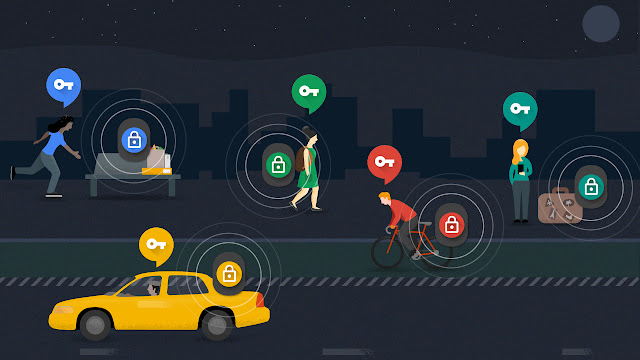Growing Eddystone with Ephemeral Identifiers: A Privacy Aware & Secure
Open Beacon Format
Posted by Nirdhar Khazanie, Product Manager and Yossi
Matias, VP Engineering
Last July, we
launched Eddystone, an open and extensible Bluetooth Low Energy (BLE)
beacon format from Google, supported by Android, iOS, and Chrome. Beacons
mark important places and objects in a way that your phone can understand.
To do this, they typically broadcast public one-way signals ‒ such as an
Eddystone-UID or -URL.
Today, we're introducing Ephemeral IDs (EID), a beacon frame in the
Eddystone format that gives developers more power to control who can make
use of the beacon signal. Eddystone-EID enables a new set of use cases
where it is important for users to be able to exchange information securely
and privately. Since the beacon frame changes periodically, the signal is
only useful to clients with access to a resolution service that maps the
beacon’s current identifier to stable data. In other words, the signal is
only recognizable to a controlled set of users. In this post we’ll provide
a bit more detail about this feature, as well as Google’s implementation of
Eddystone-EID
with Google Cloud Platform’s
Proximity
Beacon
API and the Nearby API for Android and CocoaPod for iOS.
Technical Specifications
To an observer of an Eddystone-EID beacon, the AES-encrypted
eight byte beacon identifier changes pseudo-randomly with an average period
that is set by the developer ‒ over a range from 1 second to just over 9
hours. The identifier is generated using a key and timer running on the
beacon. When the beacon is provisioned, or set up, the key is generated and
exchanged with a resolution service such as Proximity Beacon API using an
Elliptic Curve Diffie-Hellman key agreement
protocol,
and the timer is synchronized with the service. This way, only the beacon
and the service that it is registered with have access to the key. You can
read more about the technical details of Eddystone-EID from the
specification
‒ including the provisioning process ‒ on GitHub, or from our recent
preprint.
An Eddystone-EID contains measures designed to prevent a variety of nuanced
attacks. For example, the rotation period for a single beacon varies
slightly from identifier to identifier, meaning that an attacker cannot use
a consistent period to identify a particular beacon. Eddystone-EID also
enables safety features such as proximity awareness, device authentication,
and data encryption on packet transmission. The
Eddystone-TLM frame has also been extended with a new version that
broadcasts battery level also encrypted with the shared key, meaning that
an attacker cannot use the battery level as an identifying feature
either.
When correctly implemented and combined with a service that supports a
range of access control checks, such as Proximity Beacon API, this pattern
has several advantages:
- The beacon’s location cannot be spoofed, except by a real-time
relay of the beacon signal. This makes it ideal for use cases where a
developer wishes to enable premium features for a user at a
location.
- Beacons provide a high-quality and precise location signal that is
valuable to the deployer. Eddystone-EID enables deployers to decide
which developers/businesses can make use of that signal.
- Eddystone-EID beacons can be integrated into devices that users
carry with them without leaving users vulnerable to tracking.
Integrating Seamlessly with the Google Beacon Platform
Launching today on
Android and
iOS, is a new addition to the wider Google beacon platform: Beacon
Tools. Beacon Tools allows you to provision and register an
Eddystone-EID beacon, as well as associate content with your beacon
through the Google Cloud Platform.
In addition to Eddystone-EID and the new encrypted version of the
previously available Eddystone-TLM, we’re also adding a common
configuration protocol to the Eddystone family. The
Eddystone GATT service allows any Eddystone beacon to be
provisioned by any tool that supports the protocol. This encourages the
development of an open ecosystem of beacon products, both in hardware
and software, removing restrictions for developers.
Eddystone-EID Support in the Beacon Industry
We’re excited to have worked with a variety of industry players as
Eddystone-EID develops. Over the past year, Eddystone
manufacturers
in the beacon space have grown from 5 to over 25. The following 15
manufacturers will be supporting Eddystone-EID, with more to follow:

In addition to beacon manufacturers, we’ve been working with a range of
innovative companies to demonstrate Eddystone-EID in a variety of
different scenarios.
-
Samsonite and
Accent Systems have
developed a suitcase with Eddystone-EID where users can
securely keep track of their personal luggage.
-
K11 is a Hong Kong
museum and retail experience using Sensoro Eddystone-EID
beacons for visitor tours and customer promotions.
-
Monumental
Sports in Washington, DC, uses Radius
Networks
Eddystone-EID beacons for delivering customer rewards during
Washington Wizards and Capitals sporting events.
-
Sparta Digital
has produced an app called Buzzin that uses Eddystone-EID
beacons deployed in Manchester, UK to enable a more seamless
transit experience.
You can get started with Eddystone-EID by creating a Google Cloud
Platform project and purchasing compatible hardware through one of
our
manufacturers. Best of all, Eddystone-EID works transparently
to beacon subscriptions created through the Google Play Services
Nearby Messages API, allowing you to run combined networks of
Eddystone-EID and Eddystone-UID transparently in your client code!